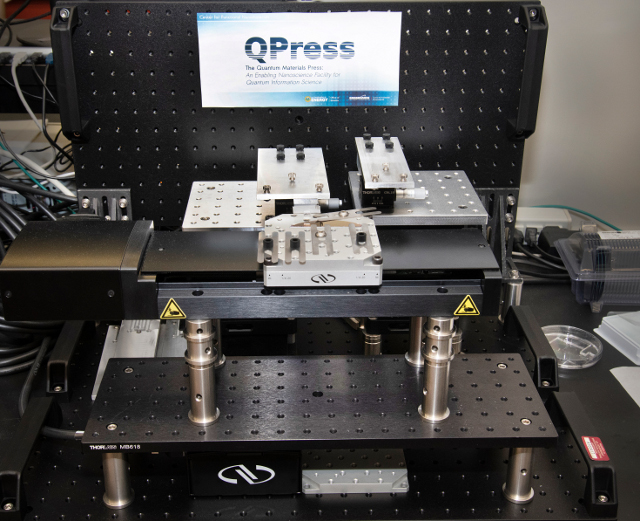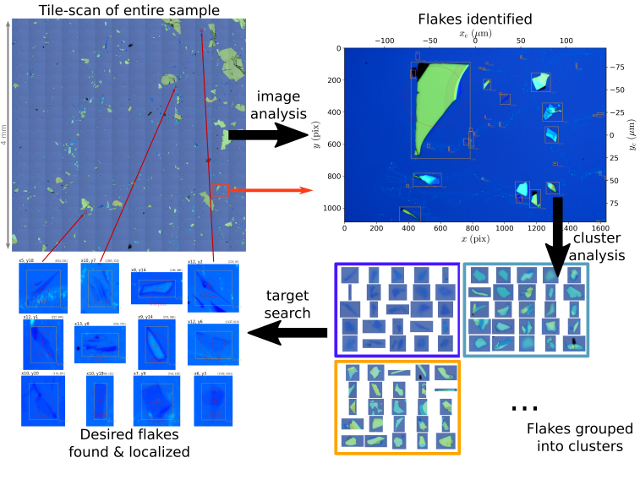Communications of the ACM
Building a Printing Press for New Quantum Materials

Brookhaven scientists (from left) Gregory Doerk, Jerzy Sadowski, Kevin Yager, Young Jae Shin, and Aaron Stein.
Credit: Brookhaven National Laboratory
Checking out a stack of books from the library is as simple as searching the library's catalog and using unique call numbers to pull each book from their shelf locations. Using a similar principle, scientists at the Center for Functional Nanomaterials (CFN), a U.S. Department of Energy Office of Science User Facility at Brookhaven National Laboratory, are teaming with Harvard University and the Massachusetts Institute of Technology to create a first-of-its-kind automated system to catalog atomically thin two-dimensional materials and stack them into layered structures. Called the Quantum Material Press, or QPress, this system will accelerate the discovery of next-generation materials for the emerging field of quantum information science (QIS).
Structures obtained by stacking single atomic layers ("flakes") peeled from different parent bulk crystals are of interest because of the exotic electronic, magnetic, and optical properties that emerge at such small (quantum) size scales. However, flake exfoliation is currently a manual process that yields a variety of flake sizes, shapes, orientations, and number of layers. Scientists use optical microscopes at high magnification to manually hunt through thousands of flakes to find the desired ones, and this search can sometimes take days or even a week, and is prone to human error.
Once high-quality 2-D flakes from different crystals have been located and their properties characterized, they can be assembled in the desired order to create the layered structures. Stacking is very time-intensive, often taking longer than a month to assemble a single layered structure. To determine whether the generated structures are optimal for QIS applications—ranging from computing and encryption to sensing and communications—scientists then need to characterize the structures' properties.
"In talking to our university collaborators at Harvard and MIT who synthesize and study these layered heterostructures, we learned that while bits of automation exist—such as software to locate the flakes and joysticks to manipulate the flakes—there is no fully automated solution," says CFN Director Charles Black, the administrative lead on the QPress project.
The idea for the QPress was conceived in early 2018 by Professor Amir Yacoby of the Department of Physics at Harvard. The concept was then refined through a collaboration between Yacoby; Black and Kevin Yager, leader of the CFN Electronic Nanomaterials Group; Philip Kim, also of Harvard's Department of Physics; and Pablo Jarillo-Herrero and Joseph Checkelsky, both of the Department of Physics at MIT.

According to Black, the unique CFN role was clear: "We realized that building a robot that can enable the design, synthesis, and testing of quantum materials is extremely well-matched to the skills and expertise of scientists at the CFN. As a user facility, CFN is meant to be a resource for the scientific community, and QIS is one of our growth areas for which we're expanding our capabilities, scientific programs, and staff."
Research Spark
The interest in 2-D materials dates back to 2004, when scientists at the University of Manchester isolated the world's first 2-D material, graphene—a single layer of carbon atoms. They used a surprisingly basic technique in which they placed a piece of graphite (the core material of pencils) on Scotch tape, repeatedly folding the tape in half and peeling it apart to extract ever-thinner flakes. Then, they rubbed the tape on a flat surface to transfer the flakes. Under an optical microscope, the one-atom-thick flakes can be located by their reflectivity, appearing as very faint spots. Recognized with a Nobel Prize in 2010, the discovery of graphene and its unusual properties—including its remarkable mechanical strength and electrical and thermal conductivity—has prompted scientists to explore other 2-D materials.
Many labs continue to use this laborious approach to make and find 2-D flakes. While the approach has enabled scientists to perform various measurements on graphene, hundreds of other crystals—including magnets, superconductors, and semiconductors—can be exfoliated in the same way as graphite. Moreover, different 2-D flakes can be stacked to build materials that have never existed before. Scientists have very recently discovered that the properties of these stacked structures depend not only on the order of the layers but also on the relative angle between the atoms in the layers. For example, a material can be tuned from a metallic to an insulating state simply by controlling this angle. Given the wide variety of samples that scientists would like to explore and the error-prone and time-consuming nature of manual synthesis methods, automated approaches are greatly needed.
"Ultimately, we would like to develop a robot that delivers a stacked structure based on the 2-D flake sequences and crystal orientations that scientists select through a web interface to the machine," says Black. "If successful, the QPress would enable scientists to spend their time and energy studying materials, rather than making them."
Modular Approach
In September 2018, further development of the QPress was awarded funding by the DOE, with a two-part approach. One award was for QPress hardware development at Brookhaven, led by Black; Yager; CFN scientists Gregory Doerk, Aaron Stein, and Jerzy Sadowski; and CFN scientific associate Young Jae Shin. The other award was for a coordinated research project led by Yacoby, Kim, Jarillo-Herrero, and Checkelsky. The Harvard and MIT physicists will use the QPress to study exotic forms of superconductivity—the ability of certain materials to conduct electricity without energy loss at very low temperatures—that exist at the interface between a superconductor and magnet. Some scientists believe that such exotic states of matter are key to advancing quantum computing, which is expected to surpass the capabilities of even today's most powerful supercomputing.
A fully integrated automated machine consisting of an exfoliator, a cataloger, a library, a stacker, and a characterizer is expected in three years. However, these modules will come online in stages to enable the use of QPress early on.
The team has already made some progress. They built a prototype exfoliator that mimics the action of a human peeling flakes from a graphite crystal. The exfoliator presses a polymer stamp into a bulk parent crystal and transfers the exfoliated flakes by pressing them onto a substrate. In their first set of experiments, the team investigated how changing various parameters—stamping pressure, pressing time, number of repeated presses, angle of pressing, and lateral force applied during transfer—impact the process.
"One of the advantages of using a robot is that, unlike a human, it reproduces the same motions every time, and we can optimize these motions to generate lots of very thin large flakes," Yager says. "Thus, the exfoliator will improve both the quality and quantity of 2-D flakes peeled from parent crystals by refining the speed, precision, and repeatability of the process."
In collaboration with Stony Brook University assistant professor Minh Hoai Nguyen of the Department of Computer Science and Ph.D. student Boyu Wang of the Computer Vision Lab, the scientists are also building a flake cataloger. Through image-analysis software, the cataloger scans a substrate and records the locations of exfoliated flakes and their properties.
"The flakes that scientists are interested in are thin and thus faint, so manual visual inspection is a laborious and error-prone process," Nguyen says. "We are using state-of-the-art computer vision and deep learning techniques to develop software that can automate this process with higher accuracy."

"Our collaborators have said that a system capable of mapping their sample of flakes and showing them where the 'good' flakes are located—as determined by parameters they define—would be immensely helpful for them," Yager says. "We now have this capability and would like to put it to use."
Eventually, the team plans to store a large set of different catalogued flakes on shelves, similar to books in a library. Scientists could then access this materials library to select the flakes they want to use, and the QPress would retrieve them.
According to Black, the biggest challenge will be the construction of the stacker—the module that retrieves samples from the library, "drives" to the locations where the selected flakes reside, and picks the flakes up and places them in a repetitive process to build stacks according to the assembly instructions that scientists program into the machine. Ultimately, the scientists would like the stacker to assemble the layered structures not only faster but also more accurately than manual methods.

The final module of the robot will be a material characterizer, which will provide real-time feedback throughout the entire synthesis process. For example, the characterizer will identify the crystal structure and orientation of exfoliated flakes and layered structures through low-energy electron diffraction—a technique in which a beam of low-energy electrons is directed toward the surface of a sample to produce a diffraction pattern characteristic of the surface geometry.
"There are many steps to delivering a fully automated solution," says Black. "We intend to implement QPress capabilities as they become available to maximize benefit to the QIS community."
No entries found